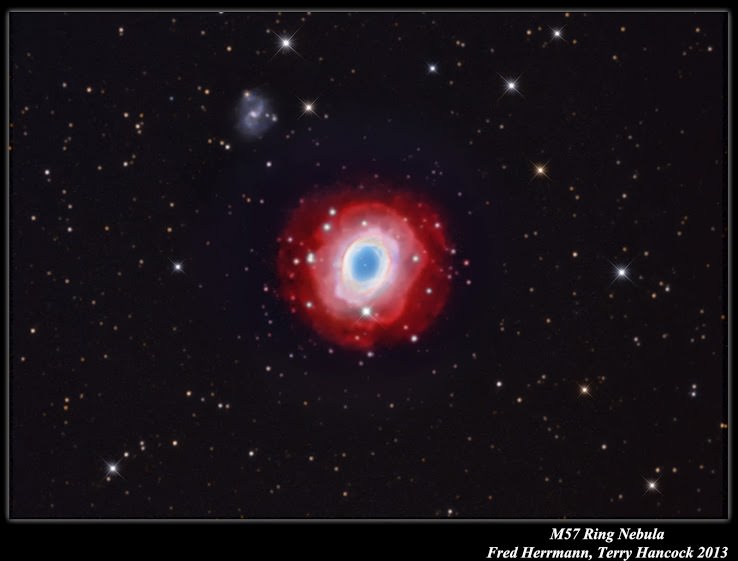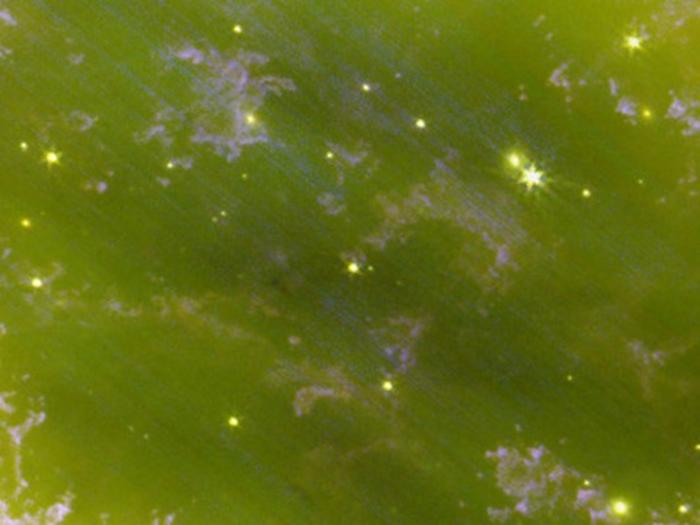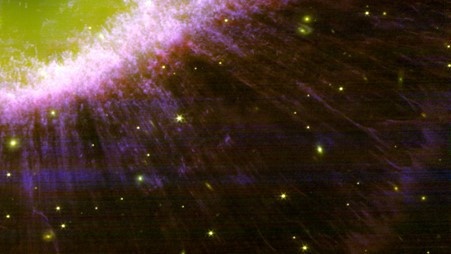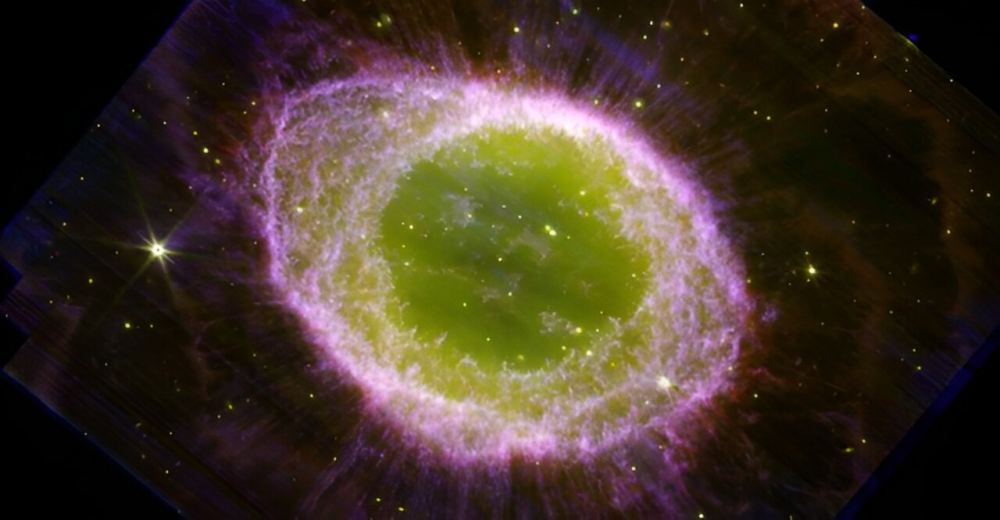Brace yourselves for great JWST views of the iconic Ring Nebula (M57). An international team of astronomers just released a fantastic near-infrared image of the nebula, showing incredible details.
The Ring is a planetary nebula in the constellation Lyra and is what’s left over at the death of sun-like star. The star in the center blew all its material away to space, which is what we see as the ring. The star itself is now becoming a white dwarf.
Astronomers have long been fascinated by this form of star death because it shows what will happen to the Sun in about 5 billion years. Albert Zijlstra, Professor in Astrophysics at the University of Manchester, said of the JWST view, “We are amazed by the details in the images, better than we have ever seen before. We always knew planetary nebulae were pretty. What we see now is spectacular.”
Planetary nebulae exist throughout the galaxy. Each one is different, and they have many shapes. Some have glowing rings, others show bubble-like structures, while others look like butterflies and wispy phantoms. In the case of the Ring Nebula, it’s really more like a jelly donut or bagel in shape, which gives some tantalizing clues to its past. Astronomers can trace the chemical elements in planetary nebulae by studying the light they emit in great detail. Those elements tell the tale of the star’s evolution through time.

An Infrared View of the Ring Nebula
In this case, JWST looked at the ring in near-infrared light using its NIRCam instrument. It’s sensitive to light that ranges from 0.6 to 5 microns (600-5000 nanometers). The human eye can see a little into the infrared, to perhaps around 0.7 microns (700 nm), so JWST extends our vision to realms where we can’t see.
According to Mike Barlow, lead scientist of the JWST Ring Nebula Project, the high-resolution views really tell much more of the Ring’s story as the star moved through its life cycle. “The high-resolution images not only showcase the intricate details of the nebula’s expanding shell but also reveal the inner region around the central white dwarf in exquisite clarity,” he said. “We are witnessing the final chapters of a star’s life, a preview of the Sun’s distant future so to speak, and JWST’s observations have opened a new window into understanding these awe-inspiring cosmic events. We can use the Ring Nebula as our laboratory to study how planetary nebulae form and evolve.”
Colors and Details
In the JWST view, colors coding shows temperatures of the ejected material at different distances from the star. Those clouds of gas and dust glow thanks to ultraviolet light streaming away from the stellar remnant. The star itself is about 100,000 degrees, which heats up the nearby clouds quite well. The rest of the material lies further out and is much cooler. Astronomers estimate that the star began ejecting its outer layers at least 4,000 years ago. Based on earlier observations, including those by Hubble Space Telescope, the outer parts of the nebula appear to be expanding at a rate of about 20 kilometers per second and is just slightly over a light-year across.

Astronomers can see more details in the nebula using the JWST’s infrared-sensitive capabilities. For example, NIRCam can peer through any surrounding dust clouds to zero in on structures in the nebula. It can also detect any material that glows in infrared light. In JWST’s view, we can now see thin streamers of material at the edges of the nebula in more detail. In addition, it identifies faint structures in the ring itself. Astronomers will study those closely to figure out what caused them.

Origin and Evolution of the Ring Nebula
The colors of the Ring are well-known from many astrophotographs, as well as views from both ground-based and orbiting telescopes. Perhaps the most famous recent view came from the Hubble Space Telescope in 2013. It shows a great deal of colorful detail, including some strange-looking “cometary knots”. Those were created as material was cast away from the star. In HST’s view, blue colors indicate hot helium emission lines, green indicates ionized oxygen, and red is ionized nitrogen.

Those colors and structures tell an interesting tale about the evolution of the Ring Nebula’s star, according to astronomer Nick Cox, a project co-leader. “These images hold more than just aesthetic appeal; they provide a wealth of scientific insights into the processes of stellar evolution. By studying the Ring Nebula with JWST, we hope to gain a deeper understanding of the life cycles of stars and the elements they release into the cosmos,” he said.
The Ring Nebula has been a case study in planetary nebulae for more than a century. Here’s what astronomers know about its origins. The progenitor star was several times more massive than the Sun. It spent much of its life doing what stars do: converting hydrogen to helium in the core. About 4,000 years ago, it ran out of hydrogen and began converting helium in its core. That caused the star to heat up and it ballooned out to become a red giant. As it did, it shed its outer layers to space. Ultraviolet light from the now-collapsing star heats up the gases, causing them to glow. The result, after several thousand years is the Ring Nebula we now see through our telescopes.
More Images to Come
The JWST NIRCam images aren’t the only ones of the Ring JWST has taken. More taken with MIRI (another infrared instrument) will be released soon. The team of astronomers working on this project hail from UK, France, Canada, USA, Sweden, Spain, Brazil, Ireland and Belgium.
For More Information
James Webb Space Telescope Captures Stunning Images of the Ring Nebula
Manchester Astronomer Captures Stunning Images of the Ring Nebula on James Webb Space Telescope

